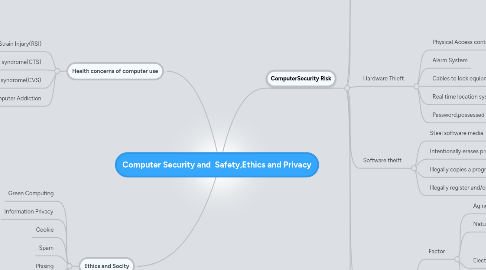
1. ComputerSecurity Risk
1.1. Internet and Network Attack
1.1.1. Thread
1.1.1.1. Computer Virus
1.1.1.2. Worm
1.1.1.3. Trojan Horse
1.1.1.4. Rookit
1.1.1.5. Backdoor
1.1.1.6. Botnet
1.1.1.7. Denial of Service Attack
1.1.1.8. Spoofing
1.1.2. Prevention
1.1.2.1. Firewall
1.1.2.2. Intrusion Detection Software
1.1.2.3. Honeypot
1.2. unauthorized access and use
1.2.1. Access control
1.2.1.1. user
1.2.1.2. password
1.2.1.3. CAPTCHA
1.2.1.4. biometric
1.2.2. Digital forensics
1.2.2.1. Law enforcement
1.2.2.2. Criminal Prosecutor
1.2.2.3. Military Intelligence
1.2.2.4. Insurance agencies
1.2.2.5. Information Security Department
1.3. Hardware Thieft
1.3.1. Physical Access control
1.3.2. Alarm System
1.3.3. Cables to lock equipment
1.3.4. Real time location system
1.3.5. Password,possessed object ,biometric
1.4. Software theift
1.4.1. Steal software media
1.4.2. Intentionally erases programs
1.4.3. Illegally copies a program
1.4.4. Illegally register and/or activates a program
1.5. System Failure
1.5.1. Factor
1.5.1.1. Aging Hardware
1.5.1.2. Nature Disaster
1.5.1.3. Electrical Power Problem
1.5.1.3.1. Noise
1.5.1.3.2. Under Voltage
1.5.1.3.3. Over Voltage
1.5.1.4. Errors in computer program
1.5.2. Protection
1.5.2.1. Surge proctection
1.5.2.2. Uninterruptable Power System
1.5.2.3. Backup
1.5.2.3.1. Full Backup
1.5.2.3.2. Selective Backup
1.6. Information Theft
1.6.1. Encryption
1.6.2. Digital Signature
1.6.3. Security Techniques
1.6.3.1. Digital Certificates
1.6.3.2. Transport Layer Security
1.6.3.3. VPN
1.6.3.4. Secure HTTP
